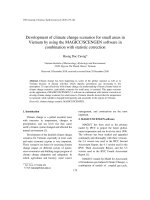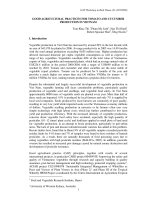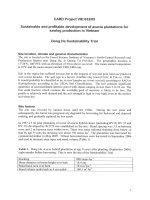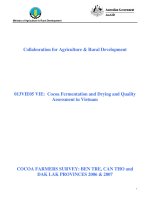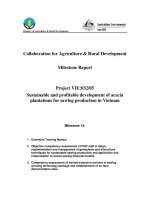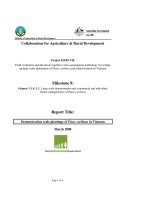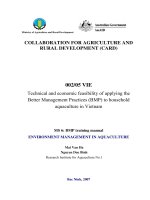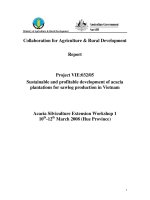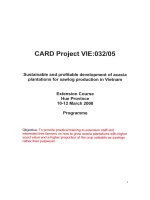Collaboration for Agriculture & Rural Development:" Sustainable and profitable development of acacia plantations for sawlog production in Vietnam - Milestone 5 " ppt
Bạn đang xem bản rút gọn của tài liệu. Xem và tải ngay bản đầy đủ của tài liệu tại đây (951.5 KB, 19 trang )
Ministry of Agriculture & Rural Development
Collaboration for Agriculture & Rural
Development
032/05VIE
Sustainable and profitable development of
acacia plantations for sawlog production in
Vietnam
Milestone 5: Baseline conditions established
C.E. Harwood, C. Beadle, Phi Hong Hai and Nguyen Duc Kien
May, 2007
1
Executive summary
This report provides baseline data relating to the growing of acacia sawlogs in
plantations in central and northern Vietnam, log harvesting and transport, and primary
processing of sawn boards in sawmills.
Growing acacia plantations for pulpwood appears to be a profitable business for
smallholder farms, many of whom are prepared to borrow from banks to establish
plantations. Acacia hybrid clones are now the most favoured planting material. A
simple spreadsheet financial model for pulpwood growing was developed indicating
that internal rate of return could be as high as 24% under baseline conditions.
Sawing technology dictates minimum acceptable log size and some mills can saw 1.5-
2 m long logs as small as 15 cm small end diameter under bark (Sedub). Under
pulpwood growing regimes, acacia plantations grown for pulpwood will produce a
small proportion of small sawlogs, even without pruning and thinning.
A 9-year-old acacia hybrid plantation in central Vietnam was sampled, and estimated
to have a mean annual volume increment of 18.9 cubic metres per hectare per year.
Of the total stand volume in this stand, 36% was potentially marketable as small
sawlogs down to 15 cm Sedub. However, trial sawing of sample logs from this
unpruned stand revealed many knot defects which substantially reduced saleable sawn
product volume.
The information collected provides a baseline against which the physical impact and
financial benefits of technologies being demonstrated in the project (pruning, thinning
and nutrition and vegetation management) can be evaluated.
Glossary
Dbhob diameter at breast height over bark
IRR internal rate of return
MAI mean annual increment
NPV net present value
Sedob small end diameter (of log) over bark
Sedub small end diameter (of log) under bark
2
Growing Acacia species in plantations
This summary of baseline conditions refers to lowland sites (less than about 800 m
elevation in southern and central Vietnam, and less than about 300 m in northern
Vietnam) receiving mean annual rainfall of more than 1400 mm. These regions were
identified in the Project review of acacia genetics (Harwood et al. 2006) as being the
most suitable environments for profitable production of acacia sawlogs.
The best acacia breeds for sawlog production are summarised in the genetics review.
Tested best clones of the acacia hybrid (A. mangium x A. auriculiformis) are the most
productive acacia variety in plantations, followed by genetically improved and tested
planting material of A. mangium and A. auriculiformis. Logs of these three varieties
are all widely accepted by sawmills in Vietnam. A. crassicarpa is another promising
fast-growing species, but not yet proven for sawlog production in Vietnam.
While, in principle, growers in almost all lowland provinces in Vietnam now have
access to the selected acacia hybrid clones of FSIV, and to good-quality seed of A.
mangium and A. auriculiformis from seed orchards or seed production areas, in
practice many recent plantations are still being established with genetically inferior
planting stock. For example, one plantation near Hue belonging to the Hue Province
Forest Development Corporation established in 2005 used seed collected from acacia
hybrid clones (ie. F
2
generation). This advanced-generation hybrid seed is highly
variable and generally poor in performance, and MARD has passed a regulation that
plantations should not be based on seed collected from hybrids, yet this is still
happening. The corporation now has moved to using only clonal plants of MARD-
approved hybrid clones, available cheaply from clonal nurseries in central Vietnam
(price 2 US cents at the nursery).
Almost all the acacia plantations in Vietnam are established at initial spacings of 1300
– 1600 stems per hectare (common initial spacings are 3 m x 2.5 m, 3 m x 2 m, 3.5 x
2 m). Occasionally a spacing of 1000 stems per hectare (4 x 2.5 m) is used. They are
grown on rotations that are clear-felled to produce a single crop of pulpwood (see
Figures 1, 2). Rotation age varies from as little as 5 years for productive sites in the
south growing acacia hybrid clones, to 10-12 years for less productive sites in central
and northern Vietnam.
Indicative pulpwood mean annual increments (MAIs) for the three main acacia
varieties obtainable from smallholder farmer plantations are shown in Table 1 below.
The values shown are MAI under bark for a 7-year rotation down to small end
diameter under bark (Sedub) of 4 cm, assuming good quality germplasm, initial
stocking of 1300 -1600 stems ha
-1
, application of a typical technology package (site
clearing and manual cultivation of planting holes sized 30 x 30 x 30 cm, at least two
rounds of thorough manual or chemical weed control, 50 grams NPK fertilizer per
tree). Good-quality forest land is assumed, with moderate slope and an average soil
depth exploitable by tree roots of at least 50 cm. These indicative MAIs are based on
figures obtained from demonstration pilot plantings on research stations reported by
Le Dinh Kha (2001) and Le Dinh Kha et al. (2003), but reduced by 20% to account
for generally lower levels of silvicultural inputs on small, farmer managed
plantations.
3
Figure 1. Four-year-old pulpwood plantation of A. mangium near Hue, central
Vietnam. Despite absence of pruning, stem form is relatively good, although lack of
singling has produced some multiple-stemmed trees.
Figure 2. Two-year-old farmer-owned and managed plantation of clonal acacia
hybrid in Quang Binh province, central-northern Vietnam, age 2 years, mean tree
height 6-7 m. Note some trees with double leaders, absence of pruning.
4
Table 1. Indicative volume production under bark from farmer acacia pulpwood
plantations (MAI to 4 cm Sedub, m
3
ha
-1
year
-1
)
Variety Northern Vietnam Central Vietnam Southern Vietnam
Acacia hybrid (best
tested clones)
10-15 12-20 15-25
A. mangium
(improved seed from
seed orchards)
8-12 10-18 15-20
A. auriculiformis
(best tested clones or
orchard seed)
6-8 8-12 12-18
Plantation productivity will be much lower on poor sites with very shallow and
degraded soils such as that shown in Figure 3. Soil water and nutrient storage
capacity, and soil volume for root system development, is insufficient to support good
growth. Improvements in genetic quality of planting stock and additional silvicultural
inputs will not deliver high productivity to such poor sites. They are not suitable for
investment in wood production plantations, and certainly not suitable for sawlog
production. One of the important challenges for plantation forestry in Vietnam is to
better identify very poor sites and avoid investment in wood-producing plantations on
these sites.
Figure 3. Poor 2-year-old plantation of acacia hybrid on skeletal, severely eroded site
just south of Hue. Yellow colour indicates tree stress and nutrient deficiency.
5
Pulpwood prices
There are over 20 woodchip mills located near ports in northern, central and southern
Vietnam. These mills export woodchips. In addition, pulp mills within Vietnam at
Bai Bang in the north and near Ho Chi Minh City purchase pulpwood.
Mill gate prices paid at Da Nang chip mill in September 2006 were as follows
• Eucalyptus wood $US 46 per green tonne (bark removed)
• Acacia wood $US 41 per green tonne (bark removed)
At the chip mill at Haiphong, the price paid for acacia and eucalypt wood is the same
(Mr S J Midgley, pers. comm., 2007). Relative price of acacia and eucalypt varies
from mill to mill.
At the Bai Bang paper mill, in March 2005, 4 metre logs to 6 cm Sed at the mill gate
received 500 000 dong per green tonne (approximately US$30 per green tonne or per
cubic metre) (S.J. Midgley, pers comm. 2007).
The prices paid to growers are lower than the mill gate prices, because the cost of
felling, transport to roadside, debarking, loading onto trucks and transport to the chip
mill must be subtracted from the mill gate price. Some forest farmers will undertake
some of these activities, rather than pay contractors to do so.
At Dong Ha station, acacia wood is purchased at the forest roadside by buyers for
400,000-500,000 dong per “double stere” (a stacked pile 2 x 1 x 1 m
3
, equivalent to
1.2 m
3
solid volume). Logs down to 4 cm Sedub are accepted for pulpwood. As the
green weight is approximately 1 tonne per cubic metre, this equates to a roadside
price, in the plantation, for pulpwood of approximately $US 20-25 per cubic metre or
per green tonne. Wood is transported in small trucks over the forest roads to the
highway, then transferred to larger trucks for the highway journey of some 200 km to
the Da Nang chip mill. A transport cost from Dong Ha town to the Da Nang chipmill
of 100,000 dong per tonne was cited. This information can be assembled to give an
approximate price structure for pulpwood (Table 2).
Obviously, farmers located further from a woodchip mill will face higher transport
costs and therefore will receive lower prices at the roadside for their acacia pulpwood.
Growers who are closer to chip mills will receive higher prices. Recently, new
chipmills have commenced operations in north-central Vietnam at Da Tuong pass
(near Chan May gulf of Thua Thien-Hue Province) and Vung Ang harbour (Ha Tinh
province).
6
Table 2. Price structure for acacia pulpwood at Dong Ha
Stage Price or cost, $US
per green tonne
Notes
Standing wood prior to
harvest
15-20
Cost of felling, bucking to 2-4
m lengths, transport to
roadside and debarking
3-5
Harvested wood at roadside in
forest, debarked
20-25 Calculated from volume price
paid per stere
Loading and transport 15 km
from plantation to Dong Ha
town in small trucks, load
onto large trucks in Dong Ha
9-10 Calculated by subtraction.
This seems rather high – need
to check on next visit
Highway transport from Dong
Ha town to Da Nang Mill
6-7 Equivalent to $0.04 per tonne
per km – seems rather low,
need to check on next visit
Price at Da Nang chipmill
weighbridge
41
Financial model for growing pulpwood
A simple financial model for pulpwood growing, produced using Microsoft Excel, is
shown in Table 3. The model assumes our best estimates for a range of costs and
returns, which will be further checked during meetings with growers and forest
extension staff. Using formulas for discounted cash flow, the model calculates net
present value (NPV) assuming a real (i.e. net of inflation) discount rate of 10%, and
internal rate of return (IRR). All costs and returns are in 2007 US dollars; the model
does not factor inflation into costs and benefits.
Under the baseline assumptions, growing acacia pulpwood is a highly profitable
business for farmers who borrow money to finance the operation. A farmer borrows
or invests a total of $US 569 over 7 years, with most costs incurred in year 1, to
achieve a stumpage value of $US 2100 at the end of year 7. This represents a net
present value of $512 for the net return on the investment and an internal rate of
return of 24%.
Many farmers now recognise plantations as a profitable farm enterprise, and are
prepared to borrow money from banks to establish plantations.
Rotation length can be as short as 7-8 years on productive sites in central Vietnam,
slightly longer in the north and as little as 5 years in the south. The baseline internal
rate of return of 24% assumes that a mean annual increment (MAI) of 15 m
3
ha
-1
under bark can be achieved for the pulpwood rotation (volume down to 4 cm sedub).
It is emphasised that site quality varies greatly. With poor plantation management, or
a poor quality site, low volume production results. An MAI of 7 m
3
ha
-1
gives an IRR
of 10%, and the investment becomes marginal.
7
Table 3. Discounted cash flow for one-hectare pulpwood plantation – base case.
Discounted cash flow model for one hectare of pulpwood plantation
Acacia hybrid all costs and returns in US dollars
Year cost
discounted
cost
return
discounted
return
NPV of
investment at
interest rate IRR
1 (388)$ ($468) -$ $981
$512 ($388) 24%
2 (31)$ -$
($31)
3 (25)$ -$
($25)
4 (25)$ -$
($25)
5 (25)$ -$
($25)
6 (25)$ -$
($25)
7 (25)$ -$
($25)
8 (25)$ 2,100.00$
$2,075
(569)$
Interest rate (real) percent interest /100 0.10
initial stocking (m x m) 3.5 2 1429 trees/ha
Costs
Year 1
site preparation 300$
planting stock @ 4 cents/seedling 57$ delivered to site
planting out (days x labour cost/day) 3 3$ 9$
NPK fertiliser (trees x amount x price) 0.1 29$ 0.20$ cost of fertilizer per kg
weeding 2 rounds (days x cost/day) 6 3$ 18$
Year 2
Silviculture costs year 2
weeding 2 rounds (days x cost/day) 2 3 6$
Recurring
Land cost (annual rent) per year 5$
Annual maintenance cost years 2-7 20$
roading, fire control, as required
Returns
MAI pulpwood under bark to 5 cm sedub 15
Final harvest year 7
pulpwood volume, cu metres 105
pulpwood stumpage price, $/cu m 20
Sawlog size and quality requirements
Because of the strong demand that has developed for acacia sawn wood, larger, sound
logs from the pulpwood harvests are directed to local sawmills, where they fetch a
much higher unit price than pulpwood logs. However, only a small proportion of the
total stand volume in unthinned, unpruned plantations is of sufficient size for sawing.
Sawing technology dictates the minimum acceptable log size. Small mills typically
use a horizontal bandsaw with logs clamped onto a rail carriage (Figure 4) and with
this type of system sawlog Sedub should generally be 18-20 cm for profitable
operation. Those mills that have vertical bandsaws where logs can be manually
guided past the blade are able to saw down to 15 cm Sedub (Figure 5).
Most of the sawn acacia wood is used for furniture components, so there is not a
strong demand for long straight logs. Acceptable log lengths at some mills can be as
little as 1.2 m. Dimensions of sawn products can be as small as 300 x 50 x 30 mm
(after drying).
8
Mill buyers typically visit harvesting operations and purchase all sound logs larger
than their acceptable minimum size. They avoid logs which are very crooked, and
those with obvious surface defects. Internal defects such as those caused by knots and
rot pockets reduce recovery of saleable product and increase production cost as they
have to be docked out during sawing.
Figure 4. Horizontal bandsaw at small sawmill at Dong Ha, sawing acacia log of
diameter 22 cm
Figure 5. Vertical bandsaw at Hue, sawing acacia log of diameter 18 cm. Log is
guided manually across log bench by two workers.
9
Figure 6. Sawmiller Mr Nguyen Si of Dong Ha discussing defects in board sawn
from acacia hybrid sawlog
Sawlog prices
The price paid for sawlogs on a per cubic metre basis is usually highest for A.
auriculiformis, followed by acacia hybrid and then A. mangium. Prices from
sawmills in central and southern Vietnam presented below are typical of the current
situation.
Table 4. Prices paid for acacia sawlogs by Huong Giang sawmill
Log small end diameter
(cm)
Price paid for acacia
hybrid logs $US m
-3
green recovery of
sawn boards (% of
log volume)
8-14 45 42
15-20 70 50
20-30 80 55
>30 100 60
Huong Giang sawmill is located on the Perfume River 10 km upstream from Hue.
These are the prices paid for logs delivered to the mill. Minimum log length is 1.5 to
2 m. Log volume is calculated as a cylinder based on log length and small end
diameter. For A. mangium logs prices paid per cubic metre are 80-85% of those
above, while prices paid for A. auriculiformis may be 10% higher. This price table is
particularly useful, as it shows the increase in unit price paid as log diameter
increases.
Mr Nguyen Si (Figure 6) operates a small sawmill at Dong Ha, which saws acacia
wood as part of its log mix. He buys acacia sawlogs from local plantations at the time
of harvest operations and transports them to his mill in his own truck. He pays $80
10
m
-3
at the plantation roadside for sound, defect-free logs greater than 20 cm Sedub
and more than 1.2 m long. This price applies to both A. auriculiformis and A.
mangium (acacia hybrid logs this size have not yet been purchased by him). Volume
is calculated from log length and small end diameter.
In March 2006, a sawmill at Dong Hoi, Quang Binh province, was paying US$80 m
-3
for acacia sawlogs of 15 cm Sedub.
In September 2003, the price for acacia sawlogs of Sedub 20 cm or greater, delivered
to the sawmill gate in Ho Chi Minh City, was $US 80 m
-3
. At this time A. mangium
sawlogs were being imported from Malaysia and sold at this price (S.J. Midgley, pers.
comm.)
Pulpwood and sawlog volumes from stands managed under pulpwood regimes.
We have made detailed measurements on a 5-hectare pilot plantation of acacia hybrid
trees grown at the North-Central Forest Research and Production Station near Dong
Ha. The stand was established in 1997 using FSIV’s best acacia hybrid clones and
good silvicultural procedures (shallow ripping along planting lines, plantation holes
cultivated to 30 x 30 x 30 cm, 50 g NPK fertilizer per tree added at planting, weed
control in years 1 and 2, singling to remove competing leaders at age 1 year). The site
quality is representative of growing conditions in central Vietnam. This stand has now
been harvested and the site will be used to plant the silvicultural trial (Project
Milestone 7).
Figure 7 shows the frequency distribution of log Dbhob in four sample plots, each of
size 21.5 x 15 m, in the 9-year-old plantation, measured in September 2006.
Frequency distribution of dbhob and stand characteristics
of nine-year-old acacia hybrid plantation at Dong Ha
0
5
10
15
20
25
11 12 13 14 15 16 17 18 19 20 21 22 23
dbh over bark (cm)
number of trees
Mean dbhob = 16.3 cm
stocking at planting 1900 sph
stocking at 9 years 890 sph
basal area at 9 years 19.4 m2 /ha
Figure 7. Distribution of dbh over bark in the ten-year-old pilot plantation of clonal
acacia hybrid at Dong Ha
11
In this plantation, initial spacing was 3.5 x 1.5 m giving a stocking of 1900 stems ha
-1
.
The stand has not been formally thinned but natural mortality and informal harvesting
have reduced stocking to 890 stems ha
-1
at age 9 years. The stand basal area was
about 19 m
2
ha
-1
, which is average for fully stocked acacia stands: basal areas greater
than 25 m
2
ha
-1
are
uncommon in acacia plantations, even in Sumatra, Indonesia
where growth of A. mangium is more rapid than in central Vietnam, MAI in excess of
25 m
3
ha
-1
commonly being achieved (Dr E. Hardyanto, pers. comm.).
In September 2006 we felled 15 trees from this plantation, randomly selected to
deliver a range of log diameters from 13 cm to 22 cm Dbhob, to study log
characteristics and make an estimate of stand volume. Total tree height was measured
and log taper was estimated by measuring diameter over bark at heights of 1.0, 1.3,
2.0, 4.0, 6.0 etc. metres above ground. Bark thickness was measured after felling at
the lower end of the log (10 cm above ground level) and at 2.0 m and 4.0 m. Figure 8
shows the plantation and one of the sampled trees before felling.
Figure 8. Dong Ha acacia hybrid plantation, age 9 years, and sampled tree.
Under-bark volumes of individual logs to top diameter of 4 cm diameter under bark
were calculated using Smalian’s formula for log sections at 1-2, 2-4, 4-6, 6-8 m etc. m
above ground. Approximate adjustments were made for bark thickness, using average
bark thickness values obtained for the different tree heights. The lowest 0-1 m section
log section (0-1 m) was estimated as a 1 m cylinder with its sedub that at 1 m. Sawlog
volumes down to 20 cm Sedub and 15 cm Sedub were estimated for each tree. To do
this, the volume of the log section in which Sedub fell below 20 cm or 15 cm was
partitioned in proportion to the diameters under bark at its lower and upper ends. For
example, if a 2 m log section had a lower end diameter of 16.0 cm and a Sedub of
12
14.8 cm, then (16.0-15.0)/(16.0-14.8cm) = 83.3% of the volume of this log section
was allocated to sawlog.
Figure 9 below shows the percentage of total volume allocated to sawlog-sized logs
greater than 15 cm Sedub, and sawlogs greater than 20 cm Sedub, for the 15 trees
sampled.
percenta
g
e of lo
g
volume to sawlo
g
for logs sampled at Dong Ha
0
20
40
60
80
100
12 14 16 18 20 22 24
log dbh over bark (cm)
% of under bark volume
%sawlog
%saw log>20 cm
Figure 9. Percentage of log volume allocated to sawlog-sized logs with Sedub > 15
cm diameter and to sawlogs with sedub >20 cm, for 15 individual trees sampled from
a 10-year-old acacia hybrid stand at Dong Ha.
The percentage of total log volume to 4 cm Sedub that can be assigned to potential
sawlogs greater than 15 cm Sedub increases linearly over the range of Dbhob from 16
to 21.5 cm, with the linear regression accounting for 96% of variance. It should be
noted that the percentages of total volumes of sawlog as purchased by buyers would
be slightly lower because buyers calculate volume as a cylinder based on sawlog
length and small end diameter under bark (or over bark, in some cases) rather than as
a conic section.
It is immediately apparent from study of Figures 7 and 9 that if growers can sell to a
sawmiller prepared to saw logs to 15 cm Sedub, a far greater proportion of the stand
volume can be sold as sawlogs. If mills accessible to the grower will only take logs
exceeding 20 cm Sedub, then unthinned acacia stands grown on pulpwood rotations
will produce very little sawlog. Thus sawing technology has a big effect on sawlog
production from acacia stands.
Volume under bark down to 4 cm Sedub, and sawlog volume under bark down to
Sedub 15 cm, were predicted for each tree in the four sample plots in this stand from
individual tree Dbhob, using linear regressions developed from the 15 sample trees.
Individual-tree volumes were summed and stand volumes expressed on a per-hectare
basis (Table 5). The equivalent mean annual increment (MAI) under bark was
calculated from stand volume and stand age. Stand value was calculated using
process at the forest roadside of $60 m
-3
for all sawlogs and $25 m
-3
for pulpwood.
13
Table 5. Total volume per hectare under bark, sawlog volume under bark, and
product values at the roadside, estimated for the 9-year-old acacia hybrid stand at
Dong Ha.
Volume
(m
3
ha
-1
)
MAI
(m
3
ha
-1
year
-1
)
Value ($US ha
-1
)
Stand volume under bark to
Sedub of 4 cm
168.1
Sawlog to 15 cm Sedub 60.5 $3628
*
Pulpwood (15 cm sedub to 4
cm Sedub)
107.6 $2690
*
Total stand value $6318
*
Price at plantation roadside $60 m
-3
for sawlog and $25m
-3
for pulpwood
The values in Table 5 are only approximate. They assume all logs down to 15 cm
Sedub can be marketed as sawlogs, whereas a proportion of these logs having severe
bends or visible defects such as rotted ends or large branch stubs will be rejected.
Also, sawlog volumes have been calculated as conic sections whereas most buyers
calculate volume as a cylinder based on sedub. Nonetheless, it is clear that in this
stand of acacia hybrid at Dong Ha, 9 years old at the time of measurement, about 36%
of the stand volume could potentially be sold as sawlogs down to 15 cm Sedub, and
the corresponding sawlog value would be about 60% of total stand value.
The under bark MAI at age 9 to 4 cm Sedub was estimated to be 18.9 m
3
ha
-1
year
-1
.
This excludes the volume of the smaller leader in those trees which are forked.
Taking this into account, MAI of volume over bark to 4 cm Sedob would be about 20
m
3
ha
-1
year
-1
.
This estimate is only approximate, because it is based on four small
sample plots on undulating terrain. There had been some informal harvest in the
stand, and this probably reduced total stand volume slightly, while increasing the
proportion of sawlog relative to an unthinned stand. If the stand had been managed
for pulpwood without any thinning, MAI over bark on a seven-year rotation would
have been in the range 20-22 m
3
ha
-1
year
-1
.
These volume measurements and sawlog estimates are from a stand about two years
older than would normally be harvested for pulpwood. Percentages of sawlogs would
have been be much lower if the stand had been harvested at age seven years for
pulpwood, as is commonly done in Vietnam.
It is emphasised that without thinning, little further increase in tree and log diameter
would be achieved by leaving the stand to grow on in a longer rotation. As pointed
out above, basal areas of tropical acacia plantations rarely exceed 25 m
2
ha
-1
, even on
the most productive sites.
Sawing performance of acacia hybrid logs from Dong Ha
A total of eighteen 2-metre logs cut from the 15 felled acacia hybrid trees sampled at
Dong Ha were sawn in an exploratory sawing study, in the small sawmill owned by
Mr Nguyen Si at Dong Ha. There were logs from the bottom 0-2 m section of ten of
14
the larger felled trees, and logs from the 2-4 m section of eight of these trees. This
sawmill uses a horizontal bandsaw, with secured held by metal dogs onto a rail
carriage which is pushed manually under the saw. Board thickness is set manually
and varied slightly according to the log being sawn. Green board thickness sawn in
this study was in the range 33-36 mm.
Disks 5 cm thick were cut from the top of the first log of ten of the trees. Wood basic
density (oven-dry weight/green volume) was measured on these discs, using the water
displacement method to estimate green volume. Mean wood basic density at height 2
m for the ten trees was 500 kg m
-3
, with a standard deviation of 30 kg m
-3
. This is
consistent with previous estimates of wood density for acacia hybrid trees.
Table 6. Logs sawn in study, showing number of boards sawn per log and range of
log small end diameter under bark
Number of
logs
Number of boards
sawn from log
Log small end diameter under
bark: mean, (range) in cm
14 3 16.3 (14.8-18.4)
3 4 18.1 (17.7-18.4)
1 5 18.2
It can be seen from Table 6 that with log small end diameter below 18 cm, it is hard to
saw more than three boards of 35 mm thickness using horizontal bandsaw systems.
This is why sawmillers with these systems prefer logs with Sedub of 20 cm or greater
– mill productivity and recovery is greatly increased if 4 or 5 boards per log can be
sawn.
Log straightness is not particularly important, as long as the bend is in a single
dimension. A bend (i.e. displacement of log mid-point from the top-to-bottom
projection) of 6 cm in one 2 m log was acceptable to the miller. Bends in two
dimensions would lead to lower recovery owing to wane and be unacceptable in
smaller-diameter logs.
Defects observed in the sawing study were dead knots, heart-rot, splits and wane. Mr
Si advised that one or two small defects on one side of a board are acceptable. One or
two very small dead knots can be covered with a small glued-in plug of clean wood.
The occurrence of defects along the length of each board was recorded.
Figures 10 and 11 show the better faces of “good” and bad” boards cut from acacia
hybrid logs in the pilot sawing study.
Figure 10. Good board from tree 1.
15
Figure 11. Defective board from Tree 12, with split and soft knots associated with
unpruned branches.
The three small sound knots in the first board, associated with live branches, would
not lead to product rejection. Splitting, and large dead knots, would make it difficult
to recover much value from the second board. Two narrow clear sections in the
middle of the board, above and below the split, might be recovered.
Clear sections are sawn to sizes specified by the buyer – minimum product size of
dried product accepted is usually 60 x 5 x 3 cm. Defects are cut out of the planks
while green by docking and re-sawing. Boards are then dried for about 20 days under
cover and racked. They are not dressed and are sold rough sawn. Price paid is 2.7M
dong ($US 164) per m
3
of sawn dried product. Larger piece sizes do not achieve a
premium price above this but better percentage volume recovery from logs is
achieved and processing cost is lower, thus improving mill profitability. It can be seen
that with a recovery of about 55-60% based on green volume (Table 3) and a log price
of $US 80 m
-3
the margin for sawmill profit is low.
All defects leading to downgrading were recorded on each board in the study, along
with their position and size along the board. This information was used to calculate
the frequency distribution of the length of clear sections that could be cut from the
boards, as shown in Figure 12.
Frequency distribution of defect-free sections of each
board in the sawing study
0
10
20
30
40
20-60 61-90 91-120 121-150 151-180 181-200
range of clear length (cm)
number of pieces
16
Figure 12. Frequency distribution of lengths of defect-free sections from the better
face of the boards in the sawing study.
It can be seen that there are many sections of the boards which are too short to meet
the minimum defect-free length. Knots, and heart-rot associated with knots, were by
far the most common defects. The proportion of clear sections longer than 60 cm as a
percentage of total board length was 72%. It is considered that pruning of branches
while green would eliminate almost of these defects. Pruning of green branches, if
extended to a tree height of 4 m, could therefore increase the yield of sound sawlog by
as much as 20% or more in this stand. It would also create longer and wider clear
sections, which if available in sufficient volume might attract a premium board price
for appearance grade products.
How such an improvement in product value can be recovered by the grower through
higher log prices will be one of the subjects addressed by our project.
Supplementary information provided
Dong Ha region, Quang Tri Province
Mr Pham Xuan Dinh, our project scientist at FSIV’s Centre for Forest Research and
Production at Dong Ha, Central Vietnam, has provided information based on his
informal surveys of many (over 30) farmers in the Dong Ha region. Part of his duties
involves purchasing pulpwood from farmers for the ViJaChip company, so he has
extensive direct experience on plantation wood production in the region with many
farmers.
Around Dong Ha, most plantations belonging to farmers and smallholders harvested
to date are of A. auriculiformis and A. mangium, because acacia hybrid cutting were
not readily available and more expensive at the time of establishment of farmer
plantations being currently harvested. Some acacia hybrid plantations belonging to
farmers are starting to be harvested now, and an increasing proportion will be acacia
hybrid in the future. Average volumes from plantation around Dong Ha are only 35-
40 m
3
/ha for A. auriculiformis and 40 - 50 m
3
/ha for A. mangium for rotations of 7 - 9
years. This equates to MAI’s of around 4-5 m
3
/ha for A. auriculiformis and 5-7 m
3
/ha
for A. mangium. Establishment cost for these farmers is low, at around 2-3 M
dong/ha.
Assuming an MAI of 6 m
3
/ha and an establishment cost of 2.5 M dong/ha ($US
160/ha), and other costs remaining unchanged from the baseline, the pulpwood
financial model indicates an IRR of 13%. It can be noted that there would be very
little sawlog produced at such low MAI.
Quang Ngai Province
In Quang Ngai Province, south-central Vietnam, farmers are growing A. mangium.
The average volume achieved is about 100 m
3
/ha on a rotation of 3 - 6 years for
wood chip. Investment at establishment is low here as well, 3 million dong/ha. They
prefer A. mangium to acacia hybrid because they regard the latter as more susceptible
to breakage by strong winds than A. mangium. This information from Quang Ngai
17
come from Mr. Le Si Sinh of the Ba To Forest Company in Quang Ngai. The
company has 3000 ha of A. mangium plantations, and they also buy wood from
nearby farmers.
Ba Vi, Ha Tay province
Station staff at FSIV’s field station at Ba Vi, Ha Tay Province, provided information
about farmer plantations surrounding the station. These farmers mostly grow acacia
hybrid plantations, on a rotation of 5-6 years, producing a volume of 55-60 m
3
/ha at
harvest, equivalent to an MAI of 9-10 m
3
/ha. Again, establishment cost of farmer
plantations is low at 2-3 million dong/ha. The financial model suggests that achieving
this growth rate at low establishment cost would be an attractive investment, with and
IRR of over 20%.
Summary
In summary, the information from these three informal surveys of farmer plantations
suggests the following conclusions:
• Volume production is lower than the baseline level used for pulpwood
plantations in the baseline financial model (5-11 m
3
/ha compared to 15 m
3
/ha
• Establishment cost of the plantations is substantially lower than the figure
used in the baseline financial model ($US 150-200/ha compared with $US
300/ha)
• These two differences tend to counter-balance one another, meaning pulpwood
plantations are still an attractive investment for farmers
• Lower volumes, and therefore average log size at harvest, mean that the
proportion of wood that can be marketed as sawlogs will be much lower than
that in the demonstration stand of acacia hybrid at Dong Ha for which we
presented data.
• Genetically improved planting stock now becoming more widely available (A.
mangium and A. auriculiformis seed from seed orchards, and cuttings of
superior acacia hybrid clones, soon to be followed by cuttings of superior A.
auriculiformis clones) should lift productivity of farmer plantations provided
farmers can access this improved germplasm at time of planting.
18
References
Harwood, C.E., Le Dinh Kha,
Ha Huy Thinh and Phi Hong Hai (2006). Review of
Acacia genetic resources and propagation methods to support sawlog production
in Vietnam. Milestone report, CARD Project Vie: 032-05.
Le Dinh Kha (2001). Studies on the use of natural hybrids between Acacia
auriculiformis and Acacia mangium in Vietnam. Agriculture Publishing House,
Hanoi.
Le Dinh Kha (2003). Selection, breeding and propagation of some main planting
species in Vietnam. Forest Science Institute of Vietnam (292 pages, in
Vietnamese with English chapter summaries)
Acknowledgments
We thank Mr Cao Dinh Hiep, mill manager of the Huong Giang sawmill near Hue
and Mr Nguyen Si, sawmiller at Dong Ha, for information they provided during visits
to their mills in September 2006. We are grateful to Mr S.J. Midgley for sharing
information that he has collected recently on log prices in Vietnam, and to Professor
Le Dinh Kha for helpful comments on a draft of this report.
19
